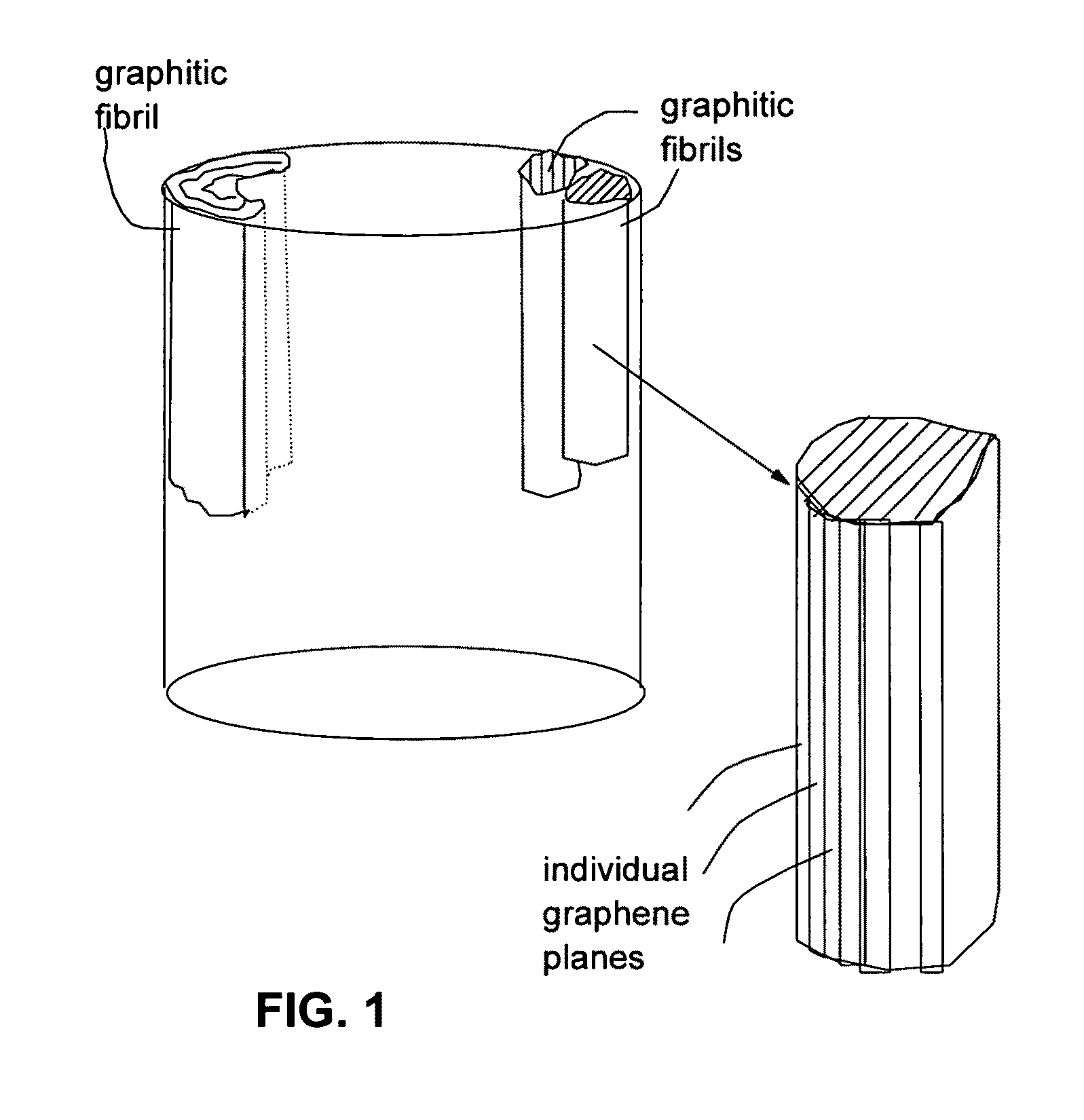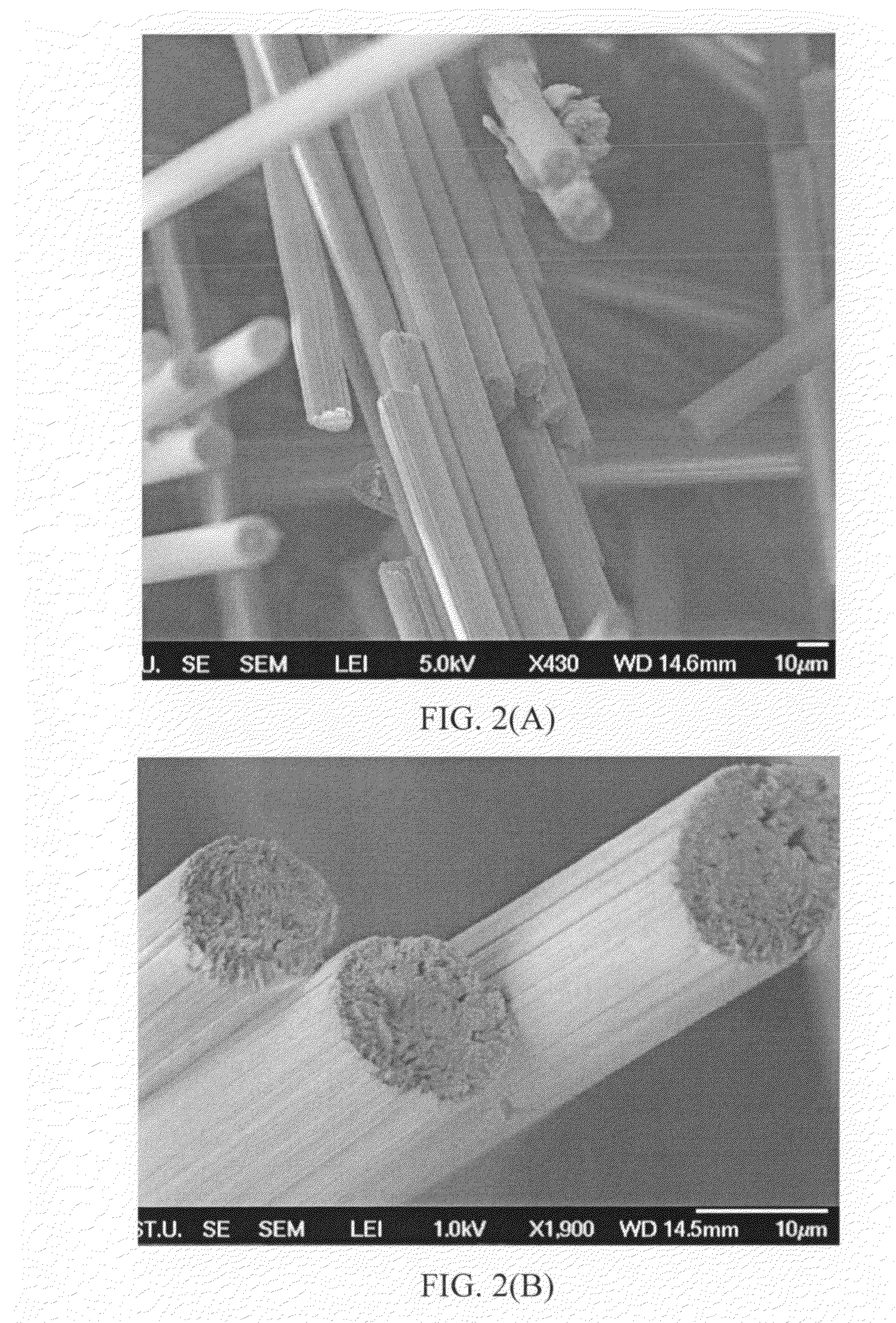Submicron-scale and lower-micron graphitic fibrils as an anode active material for a lithium ion battery
a lithium ion battery and submicron graphite technology, which is applied in the direction of cell components, electrochemical generators, transportation and packaging, etc., can solve the problems of high material cost, high material cost, and inability to meet the requirements of electro-spinning, etc., to achieve the effect of reducing the cost of cnts
- Summary
- Abstract
- Description
- Claims
- Application Information
AI Technical Summary
Benefits of technology
Problems solved by technology
Method used
Image
Examples
example 1
Graphitic Fibrils from PAN-Based Graphite Fibers
[0097]Continuous graphite fiber yarns (Magnamite from Hercules) were cut into segments of 5 mm long and then ball-milled for 24 hours. Approximately 20 grams of these milled fibers were immersed in a mixture of 2 L of formic acid and 0.1 L of hydrogen peroxide at 45° C. for 4 hours. Following the chemical oxidation intercalation treatment, the resulting intercalated fibers were washed with water and dried. The resulting product is a formic acid-intercalated graphite fiber material.
[0098]Subsequently, the intercalated fiber sample was transferred to a furnace pre-set at a temperature of 600° C. for 30 seconds. The intercalated graphite fiber was found to undergo rapid splitting into graphitic fibrils. Further separation of graphitic fibrils from split fibers was achieved using a Cowles shearing device. The fibril diameters were found to be in the range of 80 nm to 250 nm.
[0099]When an exfoliation temperature of 200° C.-600° C. was used,...
example 2
Graphitic Fibrils from Sulfuric / Nitric Acid-Intercalated Pitch-Based Carbon Fibers and Nanocomposites Containing Such Fibrils
[0100]Fifty grams each of a series of carbon and graphite fibers from Amoco (P-25, P-30X, P-55S, P-75S, P-100S, and P-120S) were intercalated with a mixture of sulfuric acid, nitric acid, and potassium permanganate at a weight ratio of 4:1:0.05 (graphite-to-intercalate ratio of 1:3) for one hour. Upon completion of the intercalation reaction, the mixture was poured into deionized water and filtered. The sample was then washed with 5% HCl solution to remove most of the sulfate ions and residual salt and then repeatedly rinsed with deionized water until the pH of the filtrate was approximately 5. The dried sample was then exposed to a heat shock treatment at 600° C. for 45 seconds. These samples were separately submitted to a mechanical shearing treatment in a Cowles (a rotating-blade dissolver / disperser) for 10 minutes. The resulting graphitic fibrils were exam...
example 3
Graphitic Fibrils from Electrochemical Intercalation and Splitting of Carbon Fibers
[0108]In a typical experiment, one gram of P-25 fibers, ground to approximately 220 μm in length, was used as the anode material and 1 L of nitric acid was used as the electrolyte and intercalate source in an electrochemical intercalation system. The anode supporting element is a platinum plate and the cathode is a graphite plate of approximately 4 cm in diameter and 0.2 cm in thickness. The separator, a glass fiber fabric, was used to separate the cathode plate from the graphite / carbon fibers and to compress the fibers down against the anode supporting element to ensure that the graphite / carbon fiber segments are in electrical contact with the anode supporting element to serve as the anode. The electrodes, electrolyte, and separator are contained in a Buchner-type funnel to form an electrochemical cell. The anode supporting element, the cathode, and the separator are porous to permit intercalate (ele...
PUM
| Property | Measurement | Unit |
|---|---|---|
| thickness | aaaaa | aaaaa |
| thickness | aaaaa | aaaaa |
| length | aaaaa | aaaaa |
Abstract
Description
Claims
Application Information
 Login to View More
Login to View More - R&D
- Intellectual Property
- Life Sciences
- Materials
- Tech Scout
- Unparalleled Data Quality
- Higher Quality Content
- 60% Fewer Hallucinations
Browse by: Latest US Patents, China's latest patents, Technical Efficacy Thesaurus, Application Domain, Technology Topic, Popular Technical Reports.
© 2025 PatSnap. All rights reserved.Legal|Privacy policy|Modern Slavery Act Transparency Statement|Sitemap|About US| Contact US: help@patsnap.com



